
|

|
This document has been prepared on contract to the New Zealand Ministry of Agriculture and Forestry as an Operational Plan to control Varroa destructor (previously called Varroa jacobsoni) in New Zealand.
The control measures described in this document have the following objectives:
A modular approach has been taken to the description and costing of the components and options of a possible control programme for varroa. This is to help stakeholders evaluate the costs and benefits of the options and choose an appropriate mix.
Discussion of compensation issues has been avoided as this is considered best left to the beekeeping industry and MAF to negotiate directly.
All of the modules described should be treated as outlines of their major components only. Before implementation, the details of the selected modules would need to be fine tuned and fleshed out in consultation with the affected parties.
A major critical assumption underlying all options presented in the Varroa Control Operation Plan is that government will attempt to keep the South Island free of varroa for as long as possible. Two programmes are presented for varroa surveillance in the South Island. The first (Entire South Island Initial Survey) is a full survey of all apiaries, and is intended to provide a baseline of information regarding mite freedom. The second (Annual Three Tier Surveillance) is designed to provide on-going information, with intensity of surveillance based on level of risk. The three tier programme includes sentinel apiaries in very high risk ports of entry, increased surveillance of high risk apiaries, and normal surveillance of all other apiaries.
Four options are presented for control of varroa in the North Island: beekeeper treatment without movement control, beekeeper treatment with movement control, coordinated control (in which government coordinates the application of treatments by beekeepers treating their own hives) and assisted control (in which government retains ownership and control of treatment materials). Pros and cons are presented for each option, and a Pest Management Strategy is discussed as a possible vehicle for administering a control programme over a longer term.
The Operational Plan includes a proposal for New Zealand-based research activities, since it is acknowledged that overseas control methods are unlikely to be directly applicable because of differences in New Zealand beekeeping practices, climatic and floral conditions, honey bee strains, and the interaction of bees viruses present in New Zealand with varroa. The goal of the research programme is to produce a sustainable control strategy that minimises cost, chemical use, and the development of resistance in mites and residues in the products that are being produced.
The Operational Plan also makes a critical assumption that extension programmes will be provided to help lessen the impact of the mite on New Zealand beekeeping, and on the horticultural and agricultural industries that rely on honey bees for pollination.
Suggested extension activities include an initial training seminar for professional apiculturalists (using an overseas expert), production and distribution of a varroa control booklet to all registered beekeepers, queen breeding courses for South Island beekeepers to help them produce their own queens now that North Island queens are not available, a variety of short courses presented over a 7 year period that are tailored to the various circumstances facing beekeepers in relation to varroa, an on-going group extension programme for sharing of experiences and information on varroa control, production and distribution of a New Zealand varroa control manual once New Zealand-based research is completed, and encouragement of the use of pollination hive quality assurance services to ensure mite impacts do not result in reduced production of horticultural crops.
A publicity programme is also included as an option to alert transport operators, beekeepers and members of the public to movement control restrictions from the North Island to the South Island.
Finally, while the Operational Plan includes various options designed to keep varroa from spreading to the South Island, options are also included for an eradication programme in the event that mites are found there.
The following critical assumptions were used in the development of this Operational Plan:
Buffer Zone - the Buffer Zone is set using a geographic separation between the upper and lower North Island. There is little movement of beehives between these two geographic areas. The Buffer Zone is the area on the north side of this geographic separation (ie, the northern North Island).
Enforcement - NBA/MAF will prosecute beekeepers who are found to have breached movement control or registration requirements.
Infected Zone - 15km radius around any apiary infected with varroa.
Movement Control, North Island to South Island - the movement of bees and other risk goods from the North to the South Island will be prohibited for as long as the South Island remains free of Varroa or while any attempt is being made to eradicate an incursion.
Natural Mite Spread - the spread of varroa between hives and between apiaries under natural conditions (no human assistance) is a product of the drift of bees between hives, the robbing of weak hives by other hives, and the absconding of bees in a heavily infested hive (resulting in the movement of the absconding bees into either a vacant hive or a hive already populated by a colony of bees). The natural spread of varroa is not likely to be greater than 5km per annum.
Sensitivity of Test - the Apistan test is considered to be highly sensitive (>83%) on a hive basis for heavy infections, and for light infections (1 varroa mite) that occurred more than one year ago. Hive level sensitivity is likely to be 50% for light infections that occurred approximately six months ago, and poor for light infections occurring within six months of testing.
Apiary site level sensitivity is estimated to be 72% for infections occurring more than six months ago. Testing every hive within an apiary, is expected to yield site level sensitivities of 89% for apiaries infected one year ago, and 76% for apiaries infected six months ago.
Testing all hives on all sites is likely to detect 90% of infected beekeepers and 99% of clusters, assuming a site level sensitivity of 89%, an intra cluster site prevalence of 37% and an intra beekeeping operation prevalence proportional to the number of sites owned by the beekeeper.
South Island Incursions - costings are provided for a single Infected Place (blip) in the South Island. The plan assumes blips will take place, but makes no prediction as to how many or when the blips will occur. All critical assumptions listed in the Eradication Operational Plan also hold true for an eradication attempt in the South Island.
Surveillance Zone - the Surveillance Zone is set using a geographic separation between the upper and lower North Island. There is little movement of beehives between these two geographic areas. The Surveillance Zone is the area on the south side of this geographic separation (ie, the southern North Island).
At this point it would appear that the South Island is still free of varroa. There are large cost benefits in keeping it free. As varroa becomes more widespread in the North Island the probability of the mite reaching and becoming established in the South Island increases. Indeed it would be prudent to treat this as a when, not if, event. To enable any incursion to be dealt with rapidly before it became too large to be economically controllable, an ongoing programme of surveillance is required in the South Island.
This section describes two surveillance programmes for the South Island. The first is intended as an initial survey to provide a baseline of information showing that the South Island is most likely mite free, or if varroa is present, providing a very good chance of detecting it. The second is designed to provide ongoing information with the intensity of surveillance based on the level of risk.
Every apiary in the South Island will be tested with Apistan strips and sticky boards. The programme will start as soon as possible and will run over 20 weeks at a time to be agreed in consultation with the beekeeping industry. An operations centre of 11 staff will be set up to manage 25 field teams. All hives in all apiaries will be tested.
The Apistan/sticky board test is the most sensitive available, but it can not detect all infected hives at very low mite population levels.
$4,770,900 (one-off)
The programme will have three levels of surveillance based on level of risk:
Very High Risk = Ports of Entry
Sentinel apiaries will be established around all South Island ports/airports of entry. This will include fourteen ports/airports and an estimated six container terminals. Six apiaries, depending on the layout of risk area, will be established around a 1km radius of the risk centre. Where possible existing apiaries will be used. If no existing apiaries are present, sentinel apiaries will be established and maintained by the contractor. All hives in each apiary will be tested twice each year.
High Risk = Beekeepers Engaged in Paid Pollination in Nelson/ Marlborough
These operations are high risk because they are both moving hives in and out of pollination, and are located in the area with the highest number of North Island to South Island movements.
All hives in all apiaries belonging to these beekeepers will be tested annually, in the period March to July inclusive. The actual time will be negotiated with individual beekeepers to ensure that access is possible to difficult sites such as high country apiaries. This will give a long enough time for a light infection picked up during pollination to build up to a level where it will be detected through the Apistan test.
Beekeepers in the surveillance programme will be required to keep very good records of their hive movements and apiary locations so that traceback can be carried out if a mite is found.
Any high-risk traces of possibly infected material from the North Island to beekeepers in the South Island (eg., queen bees shipped prior to North Island delimiting survey) will be included in the high-risk category.
Medium Risk = All Other South Island Beekeepers
From the approximately 9000 apiaries not included in the categories above, 2543 randomly selected apiaries will be tested annually. All hives in each apiary will be tested. This survey will give a 95% chance of finding an infected apiary, with 10 or more mites per hive, if 10 or more apiaries are infected.
Preference would be given to employing beekeepers who are Authorised Persons under the Biosecurity Act as contractors, to test their own hives and the hives of other beekeepers. The beekeeper contractors would be paid for this work. A competency training and testing programme would be needed for Authorised Persons.
$2,276,962 per annum
Control of the movement of hives and other potentially infected materials can be imposed to slow down the rate of spread of varroa to new areas.
Enforcement of movement control measures for beehives and other risk materials is difficult. To be effective, the controls must rely on voluntary compliance. This means the controls must be seen to be highly likely to be effective while at the same time not imposing unjustifiable restrictions on normal business activity.
There are two boundaries between zones that meet these requirements. Cook Straight provides a natural barrier across which there is little movement of bees or other risk goods. The other zone is the barrier between the current Buffer Zone and the Surveillance Zone (east to west across the centre of North Island) which is partly a topographical barrier and across which there is limited bee movement.
The largest number of movements from the North Island to the South Island leave from Wellington. The risk of infecting the South Island will be less if Wellington is made a bee free area. The issues relating to this option should be examined before varroa reaches Wellington. There are also significant ship movements from North Island ports to the South Island and it may be prudent to make a bee free zone around the Manukau Harbour as well.
Four control options are described and costed, and the value of using a Pest Management Strategy under the Biosecurity Act is discussed. All options considered in this document assume that a prohibition on the movement of bees and risk goods from the North to the South Island will remain in force as long as the South Island remains free of varroa.
The options are:
Beekeeper Treatment Without Movement Control - beekeepers pay for and manage control of varroa in their own hives without restriction (except for North to South Island ban).
Beekeeper Treatment with Movement Control - beekeepers pay for and manage control of varroa in their own hives with the only restriction that movement from the Infected or Buffer Zones in to the Surveillance Zone is prohibited.
Coordinated Control - a management agency coordinates the control of varroa on an area basis by supplying the treatment chemical to beekeepers so that they can treat their own hives. Some movement control.
Assisted Control - a management agency retains control of the methods of treatment for varroa control and treats infected hives on an area basis at no cost to the beekeeper. Some movement control.
In this option, there are no movement restrictions anywhere in the North Island. Only movement of live bees from the North to the South Island is prohibited. Movement of bee products is unrestricted, except for comb honey, raw pollen and raw propolis, which are allowed to be moved to the South Island under permit.
Beekeepers will have free access to legally available treatments, but will have to pay for the treatments themselves. Beekeepers will be fully responsible for their own disease management. It is assumed that an extension resource will be available.
Minimal cost to government, apart from small movement control requirement (not costed) and extension activities.
In this option, no movement of bees will be allowed from the Infected Zone or the Buffer Zone in to the Surveillance Zone. A low level of surveillance will be maintained in the Surveillance Zone to monitor spread. This will be targeted at main roads, migratory beekeepers and around Wellington. The restrictions will be reviewed annually and lifted once the mite becomes widespread in the Surveillance Zone.
As in the previous option, movement of bees from the North to the South Island is prohibited. Movement of bee products is unrestricted except for comb honey, raw pollen and raw propolis, which are allowed to be moved to the South Island under permit.
Hives from the Surveillance Zone will be allowed in to the Buffer or Infected Zone but will not then be allowed to leave those zones to return to the Surveillance Zone.
Beekeepers will have free access to legally available treatments but will have to pay for the treatments themselves. Beekeepers will be fully responsible for their own disease management. It is assumed that an extension resource will be available.
Enforcement will be relatively straightforward since any report of beehives moving from north to south past the Buffer Zone/Surveillance Zone boundary will be an illegal movement.
The current boundary between the Surveillance and Buffer Zone should be reviewed with the assistance of beekeepers in the affected areas. Some adjustment may reduce inconvenience to beekeepers whose operations straddle the boundary, while still retaining a significant mite barrier function
$142,450 per annum
In this option, the management agency will coordinate, in consultation with local beekeepers, the application of treatments by beekeepers treating their own hives. The treatment materials will be paid for by government, but labour costs will be borne by beekeepers. Beekeepers will be able to obtain treatment materials from a nominated distribution agency(s) under a compliance agreement, which will be audited to ensure that treatments are applied correctly.
Surveillance will be continued in the Infected Zone and the Buffer Zone to identify all newly infected apiaries so that treatment can be coordinated before infections reach dangerous levels. Feral colonies will not be eradicated by the management agency, but local beekeepers could take responsibility for this.
No movement control will be applied to hives under treatment, as it will be the beekeepers' responsibility to remove strips at the correct time.
A low level of surveillance will be maintained in the Surveillance Zone to monitor spread. This will be targeted at main roads, migratory beekeepers and around Wellington.
Movement of bees from the Infected Zone or the Buffer Zone in to the Surveillance Zone is prohibited. The restrictions would be reviewed annually and lifted once the mite was widespread in the Surveillance Zone.
Movement of bees from the North to the South Island is prohibited. Movement of bee products is unrestricted except for comb honey, raw pollen and raw propolis, which are allowed to be moved to the South Island under permit.
Hives from the Surveillance Zone will be allowed in to the Buffer or infected Zone but will not then be allowed to leave those zones to return to the Surveillance Zone.
Varroa will not affect all areas at the same time so the need for a coordinated control programme will come at different times in different areas. It is suggested that this programme run for three years in any area.
$1,874,670 - first year. It is assumed that costs will increase in subsequent years as the mite spreads to further hives. However, no rate of spread has been proposed in this Operational Plan.
Under this option, the management agency will retain ownership and control of treatment materials. Surveillance will be continued in the Infected Zone and the Buffer Zone to identify all infected apiaries and all known infected apiaries will be treated twice per year (spring and autumn). All apiaries within a 5km radius of any infected apiary will also be treated, along with all apiaries belonging to a beekeeper with an infected apiary. Known feral colonies in infected areas will be eradicated (no poisoning programme). All treatment costs will be paid for by government.
All apiaries under treatment will be placed under movement control. Movement will be allowed under permit only. This will allow the management agency to know where the treated hives are when strips need to be removed.
A low level of surveillance will be maintained in the Surveillance Zone to monitor spread. This will be targeted at main roads, migratory beekeepers and around Wellington.
Movement of bees from the Infected Zone or the Buffer Zone into the Surveillance Zone is prohibited. The restrictions would be reviewed annually and lifted once the mite was widespread in the Surveillance Zone.
Movement of bees from the North to the South Island is prohibited. Movement of bee products is unrestricted except for comb honey, raw pollen and raw propolis, which are allowed to be moved to the South Island under permit.
Hives from the Surveillance Zone will be allowed in to the Buffer or infected Zone but will not then be allowed to leave those zones to return to the Surveillance Zone.
This is a difficult option to cost accurately as it is not known how much effect the treatment regime will have on the rate of spread of varroa to new apiaries.
$5,476,629 - first year. It is assumed that costs will increase in subsequent years as mite spreads to further hives. However, no rate of spread has been proposed in this Operational Plan.
The long-term benefit to the economy of mitigating the impact of varroa is significant. As the economy as a whole will benefit, it would seem reasonable to expect government to contribute toward the cost of control in the short to medium term. It is most unlikely that the beekeeping industry would be able to pay for such a programme. In order to carry out a government-financed programme, a Pest Management Strategy (PMS) developed under the Biosecurity Act would seem to be an appropriate vehicle for programme delivery.
A PMS would contain the rules that would be used in a mandatory managed control programme. The following areas would need to be addressed in discussion over the form that a PMS might take:
A large amount of research has been conducted on varroa control methods overseas. However, these methods are unlikely to be directly applicable to the New Zealand situation. Control methods need to be related to beekeeping practice, varroa population dynamics, honey bee genetics, viral fauna and climate. All of these are likely to different in New Zealand compared to overseas.
The goal of an integrated varroa control programme in New Zealand will be to produce a sustainable control strategy that minimises cost, chemical use, and the development of resistance in mites and residues in the products being produced.
To develop an integrated control strategy for varroa in New Zealand.
The objective of this component of the research programme will be to determine the population dynamics of varroa in New Zealand.
The research will establish:
The objective of this component of the research programme will be to test the effectiveness of the currently available control methods to assess their suitability for incorporation into an integrated pest management strategy. The research will determine:
In addition to the objectives discussed above, there is scope for investing alternative control options. The New Zealand beekeeping industry has a long history of controlling diseases through management rather than chemicals, which leads to the possibility of cultural controls for varroa. Also, with the increasing amount of information that is being gained about varroa's life cycle, there are opportunities for better targeting of control options to specifically intervene in vulnerable parts of the mites life cycle.
$1,125,000 - 5 year programme
The presence of varroa mite in New Zealand presents beekeepers with an unprecedented disease control challenge, since no parasitic honey bee mites of any kind have ever existed previously in this country. Beekeepers have therefore not developed control techniques to deal with such mites, nor are such techniques (including the use of chemicals for disease control) a part of routine beekeeping management in New Zealand.
However, successful varroa mite control techniques have been developed in a number of overseas countries, and in this regard New Zealand is fortunate to be one of the last countries to become infested with the mite. The techniques developed overseas have been refined over time to be more effective in controlling varroa populations in honey bee colonies below economic threshold levels, while at the same time mitigating against chemical residues in bee products and the creation of resistant strains of mites. The techniques are based on the principles of integrated pest management (IPM) used particularly in crop protection.
Some South Island beekeepers have traditionally obtained their replacement queens from the North Island. As these will no longer be available there will be an urgent need to provide training in queen bee production methods to a number of South Island beekeepers. This needs to happen in early spring 2000 to meet the shortfall in supply that will occur in spring and autumn of the 2000/2001 beekeeping season.
The impact of varroa on the New Zealand beekeeping industry, and the horticultural and agricultural industries that rely on honey bees for pollination, can be significantly lessened by an extension programme to train beekeepers in IPM varroa control techniques. New Zealand is fortunate to have a well-developed beekeeping educational infrastructure (NBA branch structure, monthly beekeeping journal, polytech system), as well as practicing professional apiculturalists with training and experience in delivering extension programmes for honey bee disease control (eg., American foulbrood). The infrastructure and personnel can be utilised to ensure beekeepers are quickly trained in mite control techniques, both in anticipation of the arrival of the mite in a region, and once the mite has begun infesting hives in the region.
While New Zealand is fortunate to be able to adopt varroa control management techniques that have been well-tested by other countries, there will still be a need to make further refinements in those techniques to better fit New Zealand circumstances, including our different climatic and floral conditions, the way varroa may impact on our honey bee strains, and the interaction of bee viruses present in New Zealand with varroa (known as "post-mite syndrome"). There will therefore be a need for on-going research into the effects of varroa on honey bees and beekeeping management practices in New Zealand, and following on from that, extension activities to impart the new findings and techniques to the beekeeping industry as a whole.
If a decision to adopt the control option is made, and an extension services module is incorporated into the control response, the following activities could form the basis of an effective extension programme to help reduce the impact of varroa on New Zealand beekeeping, and on the horticulture and agriculture industries relying on pollination from honey bees:
The extension programme is designed to ensure there is a full and coordinated uptake of mite control methods by New Zealand beekeepers so that mite impact is held below economic threshold levels, and so that miticide residues and resistant mites do not become a problem.
As soon as possible in the winter of 2000, an appropriate overseas professional apiculturalist working in the area of varroa control extension will be brought to this country to hold a high-level (one week) training seminar for New Zealand professional apiculturalists, animal disease control specialists, and selected beekeepers.
The objective of the seminar will be to review the current world knowledge on varroa control options, and to train participants in IPM techniques being used successfully in North America and Europe to reduce the impact of the mite. Information obtained during the seminar will be used to form the basis of:
Following on directly from the seminar, a contract will be let in late winter 2000 to produce a varroa control booklet (working title: "Managing Varroa"). The booklet will incorporate current information about the mite in New Zealand, a section on mite biology, and sections on "best practice" mite survey and control techniques (IPM) that have been developed overseas. The overseas apiculturalist engaged to present the initial training seminar will act as a consultant for the booklet.
The booklet will be similar in concept to booklets produced elsewhere in the world when varroa was first discovered in a country (eg., UK MAFF booklet). Such booklets have been shown to be highly effective in sensitising beekeepers to the probable effects of mite impact, as well as forming a ready reference explaining various management techniques that should be employed. It is recommended that the booklet is distributed to all 5000 registered beekeepers in the country in spring 2000 with additional copies for regulatory personnel and new beekeepers registering for the first time.
Two queen production workshops will be held for South Island beekeepers during spring 2000. The workshops will be based on successful queen production workshops that were a feature of government apicultural extension services in the 1980's. The training will be hands-on, and will teach practical skills of setting up and maintaining starter and finisher colonies, larva grafting techniques, setting up and maintaining mating nuclei, drone production, and queen caging and banking. Theory sessions will include caste differentiation and queen bee developmental biology, basic honey bee genetics and selecting for resistance to bee diseases, and breeder selection.
Although the booklet will provide a base level of information on varroa control for New Zealand beekeepers, overseas experience suggests that adequate and coordinated incorporation of control methods by beekeepers will not occur unless there are also "hands-on" courses demonstrating those methods.
As a result, beginning in the spring of 2000 a contract will be let to develop and present a series of short courses based on the contents of the booklet. The courses will be tailored to the various circumstances currently facing beekeepers in New Zealand in relation to varroa: an "Intensive Course" for beekeepers in areas where mites are impacting on hives; a "Get Ready Course" for beekeepers in areas where the mite is soon to arrive, and a "Background Course" for beekeepers in areas where mite arrival is likely to be further out. A "Refresher Course" will be included for those areas previously receiving the Intensive Course.
The following table outlines the recommended topics to be covered in each course:
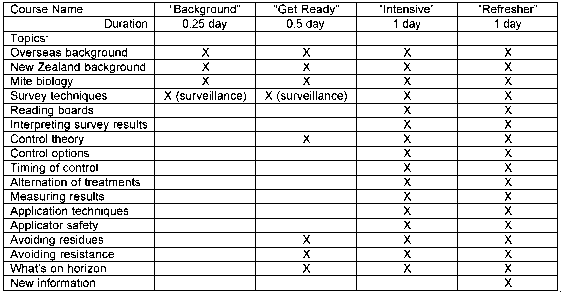
Recommended venues for the short courses are based on the existing service areas of National Beekeepers' Association branches. However, in some large geographic areas (eg., Otago branch), further venues are included within the service area (eg., Dunedin, Wanaka). The various courses will be held in the recommended venues throughout the 7 year period of the contract. For the purposes of this plan, it is assumed that varroa mite will reach the Southern North Island in 2 to 3 years, and the South Island in 4 to 5 years.
The following table outlines the recommended course venues and years when the various courses may be held (B = "Background Course"; "GR" = "Get Ready Course"; I = "Intensive Course"; "R" = "Refresher Course"):
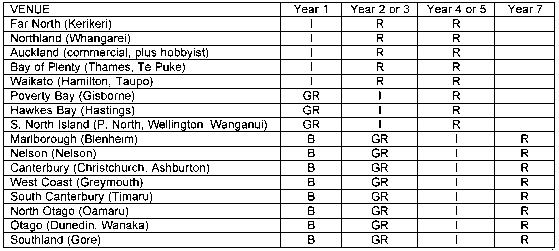
While the short courses will provide a sound basis for the transfer of recommended mite control techniques to New Zealand beekeepers, experience in agricultural extension worldwide has shown the need for on-going reinforcement of new management techniques, as well as the benefits to be obtained from group discussion of improvements to those techniques.
Therefore beginning in the spring of 2000, a contract will be let to provide group extension services regarding varroa to beekeepers throughout the country. The extension will be for a period of 7 years, and will help reinforce extension messages delivered through the booklet, the manual and the courses. The group services will also allow beekeepers to discuss control methods collectively and develop new ideas and initiatives.
The group extension will use the existing NBA branch infrastructure, and will involve professional extensionists conducting two "discussion group" style events per branch per year (spring and autumn).
Running in parallel to the extension programme will be a research programme carried out to determine economic thresholds for the mite under New Zealand conditions, the effects on colonies with and without continual re-invasion of mites, the effects of both climate and region/floral course on colony impacts, the impact of viruses in conjunction with varroa on New Zealand honey bee strains. The goal of the programme will be to determine IPM strategies most suitable for New Zealand beekeeping.
Once that research is completed, it will be essential to communicate the findings in a practical, comprehensive form to New Zealand beekeepers so that they can modify existing practices. Therefore, in the autumn of 2005 (or sooner, depending on research developments), a contract will be let to revise and enlarge the "Managing Varroa" booklet, incorporating results of research investigation in New Zealand on mite effects and control measures, and well as describing in detail "best practice" management techniques developed by New Zealand beekeepers (working title: "New Zealand Varroa Control Manual").
The manual will be practical in content and will be designed to be used directly by beekeepers and their employees. It will be similar in concept to the AFB Elimination Manual published in 1999 by the National Beekeepers' Association.
Outreach extension activities may be required to reinforce the messages presented in the manual. However, because mite control practices will be well-established in most beekeeping operations in New Zealand by the time the manual is produced, the uptake of new information modifying those practices will be easier to achieve than the establishment of totally new methods for a totally new type of bee disease. A 15 venue (NBA branch) roadshow is included in the costings for this manual. The roadshow is considered to be sufficient extension for the reinforcement of new messages contained in the manual.
It has been argued that the varroa mite could reduce the colony strength and number of foraging bees in hives used in paid pollination. An auxiliary extension activity is therefore proposed to lessen the possible impact of varroa infestation on paid pollination of crops in the horticultural and arable sectors.
The activity involves the production of articles in sector magazines highlighting the need for pollination hive quality assurance to ensure adequate strength hives are used for paid pollination. Currently, pollination hive quality assurance services are used extensively in the kiwifruit and pipfruit industries in the North Island, and have been shown to improve the average colony strength of hives put into these crops.
It is envisioned that these pollination hive strength quality assurance services will be extended to the South Island pipfruit, stonefruit, and arable (seed) industries on a user-pays basis, since growers/framers are likely to insist on pollination hive quality assurance in exchange for the predicted higher pollination fees driven by mite control costs. It is also envisioned that existing pollination hive quality assurance services in the North Island will be used more extensively by growers there, for the same reason.
$428,410 -- total cost for programme (spread over 7 years).
Although under this Operational Plan for varroa control it is assumed that varroa will eventually spread to all honey bee colonies in the North Island, it is also assumed that government will attempt to keep varroa from spreading to the South Island. Island isolation and the fact that there is little if any movement of live bees (apart from replacement queens) between the two islands means that there is a high probability of maintaining the South Island's varroa-free status (OIE definition) for a number of years.
Maintaining varroa-free status in the South Island has significant advantages for the New Zealand beekeeping, horticultural and agricultural industries in general, and the South Island components of those industries in particular. A phase-in of varroa impact through the North Island, with a significant time period before spread to the South Island, will mean the New Zealand industry in total will suffer less yearly economic loss. The loss will instead be incremental (region to region), and beekeepers in one region will develop effective control methods that can be passed on to another region (and the South Island) when the mite begins to impact in the new region. The acute phase of infection is also likely to pass in one region before infestation becomes well established in the next region.
Maintenance of varroa-free status for the South Island for as long as possible is also important since beekeeping in much of the area is reliant solely on honey production (less diversification options available), and since the honey produced (clover) is often lower in value than specialty honeys. Much of this beekeeping is carried out on marginal dryland pasture, which in turn is more dependent on clover pollination from honey bees to maintain high quality forage for stock production.
Downstream varroa impact is likely to be much greater in these South Island pasture areas than elsewhere in New Zealand, since control costs cannot easily be passed on (no paid pollination services), and since beekeeping enterprises may not be able to absorb significant cost increases (low value honey, few income diversification options). In effect, once varroa becomes established in the South Island, unless low cost control measures are developed and/or the price of clover honey increases dramatically, beekeeping in some areas of the Island may no longer be economic.
For a South Island quarantine to be successful, North Island beekeepers will need to follow established movement control rules for risk materials they may wish to send to the South Island. At the same time, transport operators will need to be made aware of the ban on a periodic basis, since they are likely to be the first line of surveillance if movement control rules are broken. There will also need to be on-going publicity of the reasons for the movement control rules to beekeepers, transport operators, and to a lessor extent the public in general. It is assumed that border surveillance for goods coming into the South Island from outside New Zealand will either continue at its present level, or increase in an effort to prevent another incursion of the mite from offshore.
The following movement control restrictions will be enforced:
Permits will be issued by the government authority upon application.
Since transport operators will be a first line of surveillance for any breaches of movement control restrictions, a contract will be let to provide on-going communication and publicity to those operators about the programme. The contractor will compile a list of operators (name, address, phone/fax/email, contact person), and will update the list on a 6 monthly basis. The contractor will also provide a written communication 4 times per year outlining movement control restrictions and who to contact in case of a breach.
A training session will also be offered to operators outlining their duties and how to identify risk goods.
A poster (see below) will be sent to each operator once per year with instructions that it be hung in a conspicuous place (eg., lunch room) on the operator premises.
A contract will also be let to mount a publicity campaign on the reasons for the movement control restrictions. The campaign will be targeted at persons most likely to be involved in movement of risk goods. The general public will not be targeted because they are unlikely to be transporting such goods.
Six articles per year will be produced and published in the New Zealand Beekeeper magazine. Two articles per year will be produced and published in other agricultural/horticultural magazines (eg., Growing Today, Grower magazine). Three articles per year will be produced and published in transport industry trade magazines.
A poster will be designed and distributed each year to 600 outlets in both islands associated with the beekeeping industry (beekeeping supply outlets, honey buyers), the transport industry (operator premises/depots, truck stops, ferry terminals, shipping terminals), the travel industry (travel agents, car rentals) and florists and flower auction houses that import flowers from the North Island. Cut flowers have been known to contain live bees after in island transport.
Transport operators may be reluctant to act as a surveillance point for the programme. It will be important to establish good relations with these operators, and public relations activities will be undertaken to get them to understand the "public good" reasons for the programme.
North Island commercial queen producers who normally supply part of their production to South Island beekeepers will be adversely affected by the movement control restrictions. There are no good figures on the size of this market, but the affect will be limited to a small number of North Island producers (approximately 5-7). It is recommended that compensation be paid to these queen producers based on an independent analysis of their sales records for the previous 3 years.
$12,100 per annum
While this Operational Plan includes a component for a North Island to South Island movement control programme to attempt to keep varroa mite from spreading to the South Island, the current section is included to provide a programme description and costings in the event varroa mite is found in the South Island.
The programme would be similar in objective and execution to the Operational Plan for Eradication previously prepared for the MAF Biosecurity Authority by AgriQuality NZ Ltd (Operational Plan for the Eradication of Varroa, MAF Biosecurity Authority, 26/5/00). For detailed explanations of activities, as well as a discussion of issues associated with an eradication plan, please refer to this previous document.
An Eradication Operational Plan for a South Island varroa incursion would include either:
Delimiting survey activities would include:
Eradication activities would include:
If high level surveillance was already being carried out and a mite was found during this surveillance, eradication would likely be a feasible option, since mite spread would be limited.
If high level surveillance was not being carried out, a decision to attempt eradication would be dependent on the outcome of the delimiting survey. Factors affecting the decision would likely include:
Factors in favour of eradication in the South Island compared to the North Island include:
$6,584,813 - with delimiting survey, one initial Infected Place
$5,912,813 - no delimiting survey, one initial Infected Place
A quality system approach would be taken toward controlling varroa. This would be described in a quality manual with procedures covering the following activities depending upon the mix of control activities chosen:
$6,720 per annum
Note: since many of the components discussed in this document are either modular or alternatives to other components, no summary of programme costs has been made.
Assumption: all hives, all apiaries, one-off

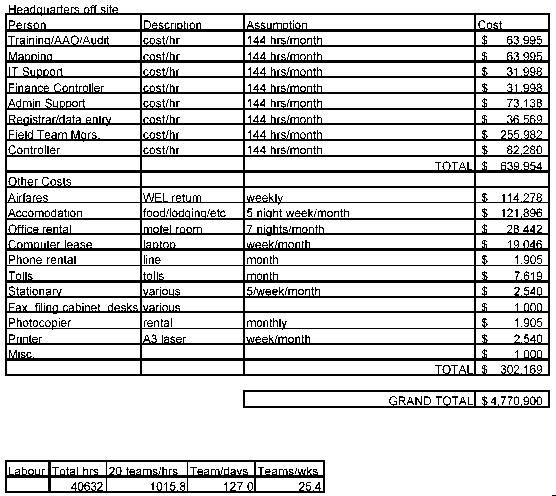
Assumptions: 20 high risk centres, 1178 high risk apiaries (pollination and North Island IP traces), rest of South Island based on 95% chance of finding 1 infected apiary if 10 or more apiary infected (10 mites or more)
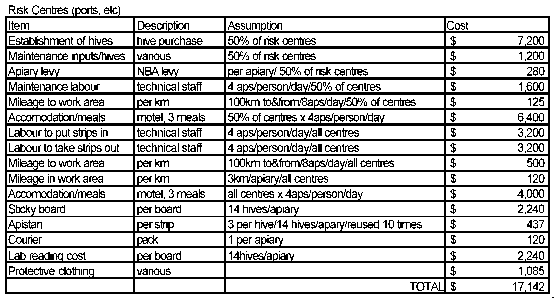
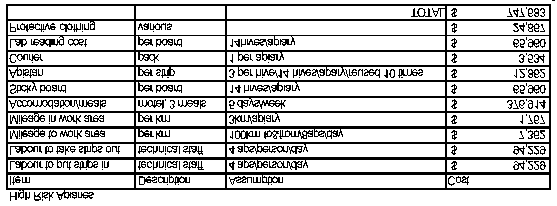
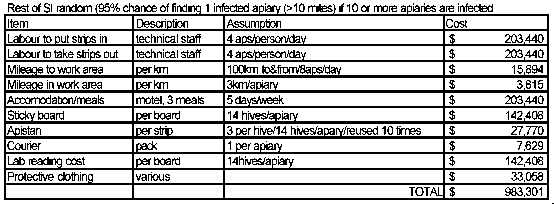
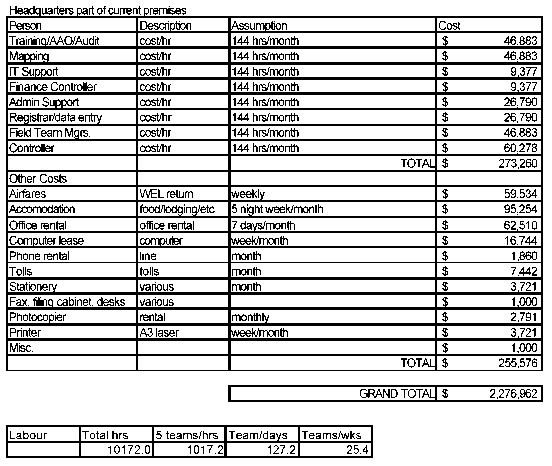
Assumptions: low rate of surveillance (10% of apiaries, targeted to Wellington, main roads, migratory beekeepers); no movement of bees/hives from Infected Zone or Buffer Zone to Surveillance Zone.
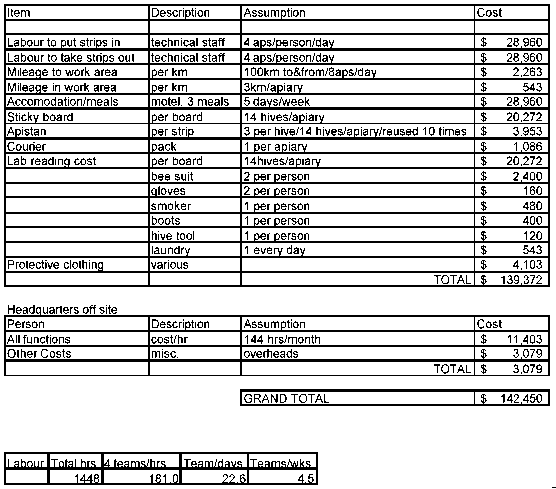
Assumption: government agent applies treatment; continued surveillance in Buffer and Surveillance Zones to identify new infestations
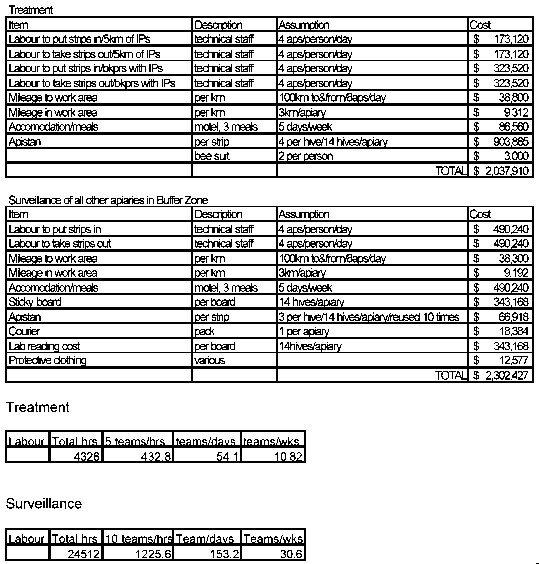

Assumption: government agent coordinates treatment application by beekeepers on own hives; continued surveillance in Buffer and Surveillance Zones Treatment
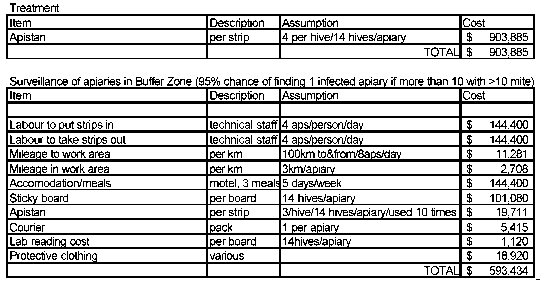
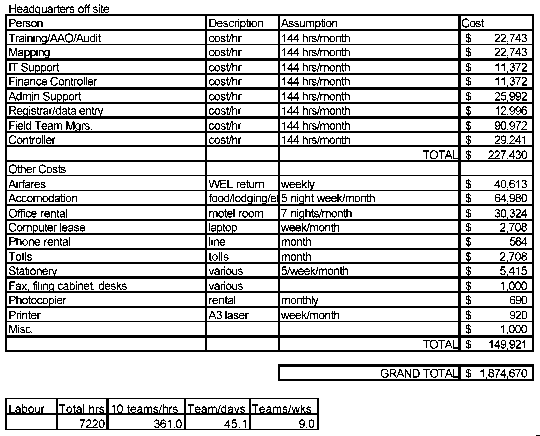
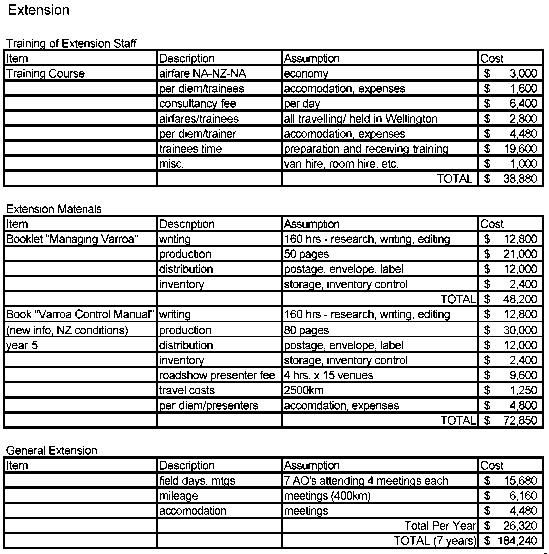

$100,000 per annum for 5 years
$125,000 per annum for 5 years
$1,125,000

Assumption: no high level surveillance previously, delimiting survey required; one Infected Place, 15km Eradication Zone
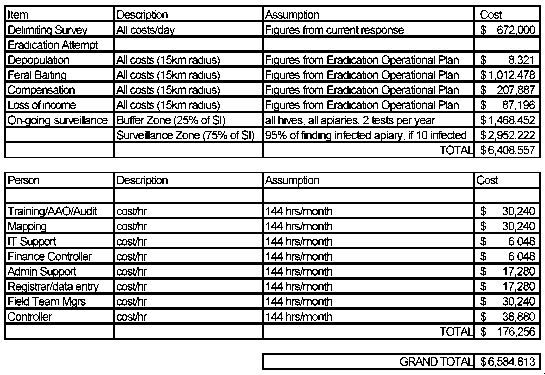
Assumption: high level surveillance previously; no delimiting survey required; one IP, 15km Eradication Zone


Home NZ Bkpg Bee Diseases Organisation Information Contacts
, webmaster of the site...